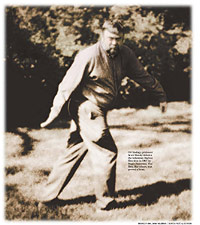Bigfoot Encounters
BIOLOGY meets BIGFOOT
Ohio University scientist uses forensics to track nature's mysteries, including Sasquatch sightings
by Mike Lafferty -- Tuesday, May 02, 2006 -The Columbus Dispatch
 Photo: Ohio University forensic biologist-professor Scott Moody mimics the infamous Bigfoot walking in the film shot in 1967 by
Photo: Ohio University forensic biologist-professor Scott Moody mimics the infamous Bigfoot walking in the film shot in 1967 by
Roger Patterson.
Scott Moody is willing to give just about anyone the benefit of the doubt.
Until the facts are in, that is. The evidence doesn't lie.
That's why Moody, a 57-year-old forensic biologist at Ohio University, didn't automatically dismiss numerous Bigfoot sightings in Ohio through the years until he investigated one particular event.
Now, Moody says he thinks that Bigfoot sightings in Ohio are nothing more than myth.
He says so in a paper he presented recently to the annual meeting of the Ohio Academy of Science.
Most scientists stay away from Bigfoot research, but Moody uses it to entice students to consider forensics as a career. In addition, scientific advances enable a few interested researchers to attack the Bigfoot legend with new techniques, especially genetics analysis.
Moody investigated a May 2002 sighting north of Rt. 50 on Haga Ridge Road, property that borders the Wayne National Forest in eastern Athens County.
"That's where I butted heads with some of the Bigfoot people who want to believe everything they see out there," Moody said. "This case has no evidence whatsoever."
The residents reported finding footprints, seeing "red eyes" and hearing screams in the night. In this case, Moody said, Bigfoot also supposedly left hair and tracks on a rural graveled lane.
The family's teenage son said he encountered a 7-foot-tall, white furry creature standing behind a tree. He ran to the family's trailer, according to the report filed on the Ohio Bigfoot Research Organization's Web site.
But using forensic techniques, Moody determined reality to be a lot more boring.
The owners of the property where the sighting occurred had just had a load of gravel spread. Afterward, it rained and water flowed down the lane, picking up pieces of gravel, stirring eddies and digging little trenches.
"These were being interpreted as toe impressions," Moody said.
No doubt an easy mistake to make after you've seen a 7-foot-tall creature peering at you from behind a tree.
The hair turned out to be from a whitetailed deer.
"People think forensics is only DNA from a dead human body," Moody said.
Think CSI meets Nature.
Bigfoot is perhaps the ultimate fugitive, so it makes sense to explain forensics to prospective students attending the science meeting.
Moody said most students enter the Ohio University program with hopes of getting jobs like those they see on TV programs. But they are stunned by the amount of biology, chemistry and physics they have to study.
By graduation, 75 percent of students who started in forensics have changed majors, Moody said.
Demand for forensic investigations is being driven by the $10 billion market in illegal wildlife skins and pelts, bear gallbladders, ground rhinoceros horn, alligators and rare birds.
Authorities want proof when they prosecute offenders. That means investigators must be skilled in DNA sampling and using an electron microscope to identify different types of buckshot or elephant ivory.
While law-enforcement forensics deals only with humans, wildlife forensic scientists must identify evidence from any species in the world that is illegally killed, smuggled, poached or sold.
That entails identifying fur in a coat and determining whether seaturtle oil has been used in suntan lotion.
Then there's the more mundane. In 2004, Moody's forensics skills helped an Ohio food-products company when a customer found frog parts in a frozen pizza.
The company blamed its suppliers, he said.
Moody traced the vegetables to growers in Mexico and Ohio, but because he confirmed the frog was a chorus frog, the Mexican growers were off the hook. The frogs simply don't live there.
They do, however, live in central and northwestern Ohio, where some of the vegetables were grown.
Although he dismisses most reports of Bigfoot in the eastern United States, Moody said he thinks that 8-foot-tall, 500-pound beasts with 8-inch-wide feet could be living deep in the mountains out West.
Forensic evidence has been found: primate hair and footprints with dermal ridges, which are similar to the ridges on fingerprints.
Footprints with those dermal ridges would be difficult to fake, he said.
Don Keating, a longtime Bigfoot searcher from Newcomerstown, said there is no reason why Bigfoot should not live in Ohio. Bears do, he figures.
He counts more than 250 sightings in Ohio. But Bigfoot searcher Tom Biscardi, of Menlo Park, Calif., thinks there are as many as 3,500 such creatures roaming the United States, including Eastern states. One of his most memorable experiences occurred near Portsmouth a few years ago, when he was leading a small night expedition.
He said the quiet night air suddenly split with the bloodcurdling scream of a Bigfoot.
"Those poor people were scared to death," he said. "One even peed his pants."
mlafferty@dispatch.com
- ---
Back to Stories?
Back to Bigfoot Encounters Main page
Back to Newspaper & Magazine Articles
Back to Bigfoot Encounters "What's New" page
Portions of this website are reprinted and sometimes edited to fit the standards of this website
under the Fair Use Doctrine of International Copyright Law
as educational material without benefit of financial gain.
http://www4.law.cornell.edu/uscode/17/107.html
This proviso is applicable throughout the entire Bigfoot Encounters Website.